8 Best Compound Microscopes of 2024 – Reviews & Top Picks
Last Updated on
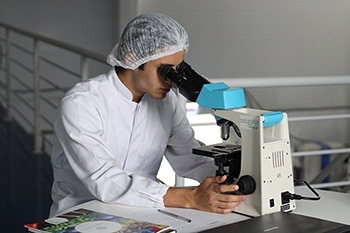
Whether you’re a student, collector, hobbyist, or professional, a compound microscope can be a very useful tool across many different fields. If you’ve recently decided to purchase a new compound microscope, deciding which one to get can be a daunting decision. There are so many available these days and they offer many different features: multiple lenses, different magnification levels, single-eyepiece, and dual-eyepiece designs, and more. Some are portable and offer battery-powered illumination for fieldwork, others may lack portability but offer very high levels of magnification and superior focusing abilities.
If you’re looking for a shortcut to picking the best microscope, then we’ve compiled the following eight reviews to help you narrow down your search. We’ve tested as many as we could find, and these were the ones that we felt performed the best. The top three stood out above and beyond the rest though, which is why they’re the ones that have earned our recommendations.
A Quick Comparison of Our Favorites (2024 Update)
| Image | Product | Details | ||
|---|---|---|---|---|
| Best Overall |
 |
AmScope Biological Compound Microscope |
|
CHECK PRICE |
| Best Value |

|
My First Lab Compound Microscope |
|
CHECK PRICE |
| Premium Choice |
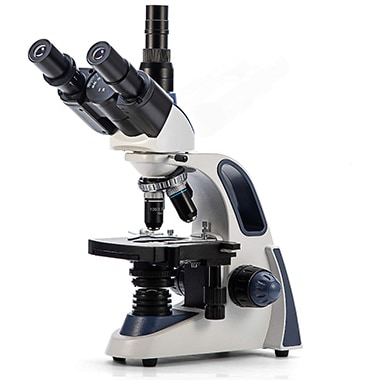 |
Swift Compound Lab Microscope |
|
CHECK PRICE |
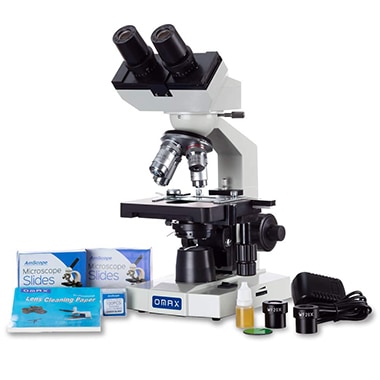 |
OMAX Binocular Compound Microscope |
|
CHECK PRICE | |
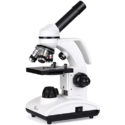 |
TELMU Lab Compound Monocular Microscopes |
|
CHECK PRICE |
The 8 Best Compound Microscopes
1. AmScope Biological Compound Microscope – Best Overall

Ruggedly built and reasonably priced, the AmScope M150C-I was our favorite compound microscope overall. The all-metal framework lends to the sturdy feel. Five different magnification levels are available, ranging from 40X to 1000X. This isn’t as high as some of the more expensive models, but it’s still sufficient for most uses. There’s an LED illumination system built-in which we found to be very useful. Even better, it can be powered by the included wall adapter or three AAA batteries, making it fully portable for field use.
We liked the overall feel of this microscope and trusted its rugged construction to last through tough fieldwork conditions with ease. It also focused very easily and quickly thanks to the dual coarse and fine adjustment focusing knobs. While this microscope is great for users of all levels, it didn’t include any sort of instructions, so beginners may be a bit confused as they try to find their way around the microscope the first time.
- 5 magnification settings from 40X-1000X
- LED illumination
- Battery power or wall adapter
- Reasonably priced
- No instructions or manual included
2. My First Lab Compound Microscope – Best Value
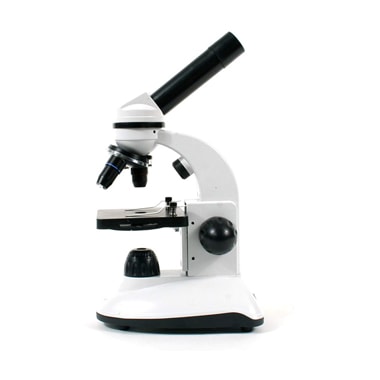
The My First Lab Duo-Scope Microscope is a high-quality yet affordable device that we think is the best compound microscope for the money. It includes an accessory kit with useful items such as slides, plastic dropper, lens paper, forceps, petri dish, and more. This makes it a great option for beginners and children. It’s capable of 40X, 100X, and 400X magnification levels. Unfortunately, this isn’t high enough for some professional applications, but it’s still sufficient for school use.
Thanks to the dual-LED illumination, you’ll always be able to see your specimens in perfect clarity. One light is positioned above your slides to illuminate the top. The other light is positioned below your slide to illuminate from the bottom. You’ll need three AAA batteries to power it, making it fully portable. There is no wall adapter, however, which is a minor drawback. Altogether, we think it’s hard to beat this feature set and quality for the price.
- Affordably priced
- Real glass optics with 3 magnification levels
- Dual LED illumination
- Battery-powered for portability
- Includes useful accessory kit for beginners
- Only magnifies to 400X
- No wall adapter included
3. Swift Compound Lab Microscope – Premium Choice

You can tell as soon as you lay eyes on the Swift SW380T Trinocular Compound Lab Microscope that it’s an impressive beast. Once you use it, you’ll see that the performance lives up to and even exceeds expectations in every facet. It’s got a pretty high sticker price, but after feeling the quality and realizing how many features are packed into this device, you’ll see that it earns the premium price tag. For one thing, dual eyepieces make it much easier to see clearly and bring things into focus. It’s also much more comfortable to use for this reason since you’ll never have to squint or constantly readjust to find the right angle.
Thanks to the dual 10X and 25X eyepieces, you get six different magnification levels ranging from 40X all the way up to 2500X, making this one of the most powerful microscopes that we tested. We were very impressed with the ease of focusing the Swift SW380T. The fine adjustment knob was very smooth and pulled things into focus very quickly, every time. We also appreciated the addition of the camera port which allowed us to take pictures and videos of what we were seeing.
- Dual eyepieces
- 6 magnification levels up to 2500X
- Built-in camera port
- Fine adjustment knob
- Very expensive
4. OMAX Binocular Compound Microscope

The OMAX Binocular Compound Microscope is a competent product that just missed our top three. We like the dual eyepiece build of this device that makes for much better viewing and easier focusing compared to single eyepiece microscopes. This one has four objective lenses that allow for eight different levels of magnification. We appreciated the diversity of this, but the range wasn’t as great as hoped since the highest level of magnification offered is 2000X. This is still better than many competitors, but not as high as the 2500X offered by the Swift SW380T in our third position. This microscope is a little bit cheaper, but it’s still on the expensive side.
The separate coarse and fine adjustment knobs made it easy to dial in the proper focus. Overall, we felt that the operation of this microscope was solid except for one glaring flaw. With the slide in place, you can’t switch objective lenses because they hit the retaining screw when the unit turns. This adds quite a bit of work each time you want to change magnification levels and held the OMAX microscope back from achieving our recommendation.
- Coarse and fine adjustment knobs
- Dual eyepieces
- 8 magnification levels
- Expensive
- Have to remove slide to switch lenses
- Only goes up to 2000X magnification
5. TELMU Lab Compound Monocular Microscopes
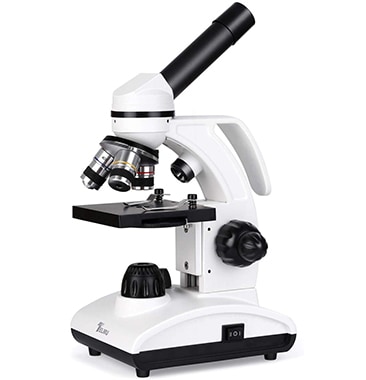
Affordably priced but cheaply built, this compound monocular microscope from TELMU is a low-cost way to get started with a microscope, but it’s not the one we’d suggest. That said, it does have some decent features for a microscope at this price. For instance, we liked the Dual LED illumination system that made it easy to see every specimen we looked at, no matter what it was or what light conditions we were working in. It requires three AA batteries to run so it’s totally portable. Unfortunately, no wall adapter was included so you’re stuck using batteries.
We weren’t impressed with the poor optic quality of this microscope compared to similarly priced competitors. Even when fully focused it just wasn’t as sharp. It’s also got a cheap feel thanks to the plastic construction and we prefer the metal build that’s available on many other models in the price range. We did like the smartphone adapter which allowed us to take videos and pictures easily, but it wasn’t enough to redeem this microscope in our eyes.
- Affordably priced
- Smartphone adapter and eyepiece for pics and video
- Dual LED illumination system
- Cheap plastic construction
- Poor optic quality
6. Celestron Compound Binocular Microscope
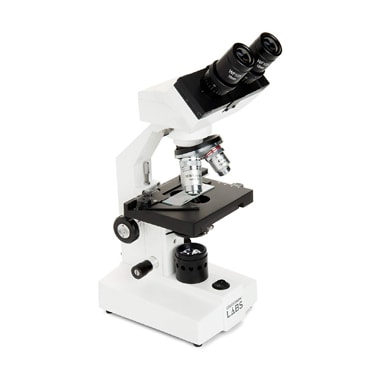
We felt that the Celestron CB2000CF Compound Binocular Microscope was an expensive microscope with cheap construction and feel. Not a great combination in our eyes, which is why this microscope hasn’t been placed very high on our list. It does have some redeeming qualities, though. For example, it offers eight different magnification levels, thanks to the four fully achromatic objective lenses and the interchangeable 10X and 20X eyepieces. The range spans from 40X up to 2000X, which is quite respectable, though not the best that we saw for the price. The Swift SW380T that earned our premium recommendation is priced similarly but offers magnification up to 2500X.
Thanks to the binocular eyepieces, the Celestron is comfortable to use and easier to focus than single eyepiece models. It features lower illumination with an adjustable halogen bulb, a nice feature. However, there is no illumination from the top, something we always prefer to see. This one must be plugged in for the lights to work, so it’s not truly portable. The dual coarse and fine focus adjustment knobs help dial in your exact focus, and operation was stable overall.
- Dual eyepieces
- 8 magnification levels
- Expensive
- Cheap construction and feel
- No illumination from the top
7. ZENY Biological Compound Microscope

We were rooting for the ZENY Biological Compound Microscope because it’s one of the cheapest models that we got to test. Unfortunately, we felt that the performance it offered was just on par for the price. The build quality and construction feel cheap overall. Likewise, the optical quality wasn’t the greatest. Compared to other microscopes of a similar price, it was outperformed by most. With magnification levels from 40X to 1000X, this microscope doesn’t offer high enough magnification to suit all applications, but that’s not really what’s holding this device back.
There is a built-in LED for illuminating your specimens. We felt that it simply wasn’t powerful enough to make things visible. You can power it with either three AA batteries or the included wall adapter. We think the features are great for the price, but the performance just doesn’t meet our needs. The weak LED light coupled with the poor quality of the lens optics makes it difficult to get a clear image, even when it’s completely in focus. The low price is certainly appealing, but we suggest getting something with a higher build quality such as the MFL-06 that earned our pick for the best value.
- Very cheap
- Doesn’t have high enough magnification
- LED doesn’t get bright enough
8. Gosky Biological Compound Microscope
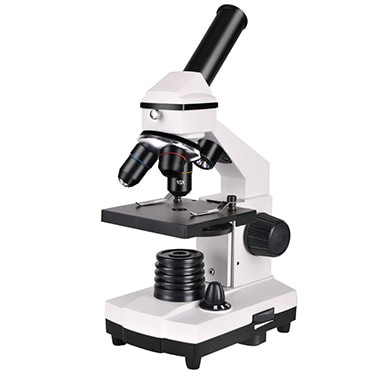
Despite being more expensive than many of the similar models we tested for this list, the Gosky 1280 Biological Compound Microscope is a relatively weak offering that didn’t do much to impress us. Like many similar microscopes, the Gosky offers three switchable objective lenses with a range of magnification levels. It offers six different magnification settings to choose from, but unfortunately, the range is very limited, spanning from 40X to just 640X. Many of the lower-priced models we tested offered much higher magnification ranges than this.
We greatly prefer the dual eyepiece models for their easier and more comfortable usability. The Gosky only offers a single eyepiece though it’s priced closer to the higher-end dual eyepiece devices. That said, it also includes a smartphone adapter that allows you to take pictures and videos of whatever you’re viewing. We also appreciated the dual LED illumination system that supplies light from below and above the specimen.
- Smartphone adapter
- Only magnifies to 640X
- More expensive than better competitors
- Single eyepiece
Buyer’s Guide: Choosing the Best Compound Microscope
Now that you’ve read about eight of the best compound microscopes available, you may be wondering which features matters most and which you could do without. While they all perform the same basic functions, differences in magnification levels and more separate each of these devices from each other. Before we dig into their different features though, let’s define what a compound microscope is.
What is a Compound Microscope?
Compound microscopes are the same ones that most of us used in high-school biology classes. They have multiple objective lenses that can be switched between. Each objective has its own magnification level, spanning from 40X to 1000X on most devices, but some can get reach even higher levels of magnification than this. It will have a base with a light in it. Your slide will sit on the base with the light illuminating up through it. This allows you to see what’s going on inside of your specimen, not just on the surface. That’s what makes a compound microscope so special. It allows you to see what’s going on inside of a two-dimensional specimen.
Magnification Levels
To see the microscopic world, compound microscopes are equipped with several different objectives, usually three or four. So, how much magnification do you really need? Well, it depends on what you want to look at. You can start to see individual cells and even some bacteria at around 400X magnification. For that reason, 400X is the minimum you’ll want your microscope to be able to magnify. If you wish to see the detail of the cell and smaller bacteria, then you’ll want a microscope that’s capable of 1000X magnification. Some of the most powerful ones we tested could enlarge up to 2500X. You may never need to magnify by this much, but it’s an impressive capability.
- You might also be interested in: How to Use a Microscope: A Beginner’s Guide
Optic Quality
So, what separates two microscopes with the same levels of magnification that sell for drastically different prices? Optical quality is likely the biggest difference between them. Though they may both offer 1000X magnification, if one has poor optical quality, you may not be able to get a clear image through the lens at 1000X. High-quality glass lenses are expensive, and this is where most of the money goes on a higher-end microscope. The best microscopes use the highest-quality lenses to provide the clearest image with a wide field of view.
Monocular vs. Binocular Microscope
You may notice that some of the higher-end microscopes we reviewed have two eyepieces instead of just one. A microscope with a single eyepiece is a monocular microscope while one with two eyes is called a binocular. Monocular microscopes tend to be cheaper and more common. However, binocular microscopes offer some advantages that make them worth the extra cost. A binocular microscope has a larger field of view so you can examine a lot more of your specimen at once. They can also achieve higher resolution images and it’s much easier to focus since you are using both of your eyes instead of just one. For most basic work, a monocular microscope is sufficient. But if you want the best image with the largest field of view, then a binocular microscope is worth considering.

Conclusion
When looking for a compound microscope, there are many options to choose from. They vary drastically in magnification power, build-quality, and price. Hopefully, after reading our reviews, you have a good understanding of some of the features you’re looking for and which microscopes may offer those features. Likewise, you should also know which to stay away from. In the end, our favorite was the AmScope M150C-I Biological Compound Microscope. It features solid metal construction, LED illumination, five magnification settings, and battery-powered portability all for a very reasonable price.
Our pick for the best value was the My First Lab MFL-06 Duo-Scope. The real glass optics provided a great viewing experience and the dual-LED illumination made sure that every specimen was well lit and completely visible. The accessory kit was full of useful items that were great for a beginner, and it was one of the most affordable microscopes we tested. Finally, Swift SW380T was an impressive device that earned our premium choice. It’s our recommendation when you need professional performance with six levels of magnification up to 2500X, dual eyepieces for easy viewing and focusing, dual coarse and fine adjustment knobs, and even a built-in camera port.
Featured Image Credit: luvqs, Pixabay
Table of Contents
- A Quick Comparison of Our Favorites (2024 Update)
- The 8 Best Compound Microscopes
- 1. AmScope Biological Compound Microscope – Best Overall
- 2. My First Lab Compound Microscope – Best Value
- 3. Swift Compound Lab Microscope – Premium Choice
- 4. OMAX Binocular Compound Microscope
- 5. TELMU Lab Compound Monocular Microscopes
- 6. Celestron Compound Binocular Microscope
- 7. ZENY Biological Compound Microscope
- 8. Gosky Biological Compound Microscope
- Buyer’s Guide: Choosing the Best Compound Microscope
- Conclusion
About the Author Robert Sparks
Robert’s obsession with all things optical started early in life, when his optician father would bring home prototypes for Robert to play with. Nowadays, Robert is dedicated to helping others find the right optics for their needs. His hobbies include astronomy, astrophysics, and model building. Originally from Newark, NJ, he resides in Santa Fe, New Mexico, where the nighttime skies are filled with glittering stars.
Related Articles:
How to Clean a Refractor Telescope: Step-by-Step Guide
How to Clean a Telescope Eyepiece: Step-by-Step Guide
How to Clean a Rifle Scope: 8 Expert Tips
Monocular vs Telescope: Differences Explained (With Pictures)
What Is a Monocular Used For? 8 Common Functions
How to Clean a Telescope Mirror: 8 Expert Tips
Brightfield vs Phase Contrast Microscopy: The Differences Explained
SkyCamHD Drone Review: Pros, Cons, FAQ, & Verdict



